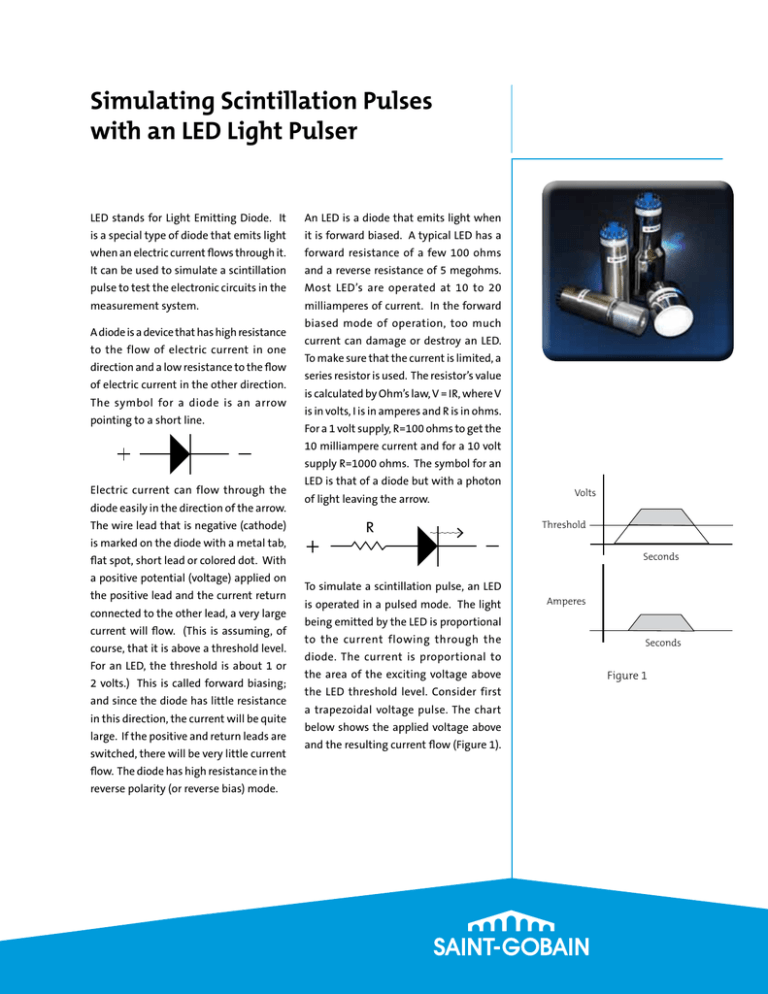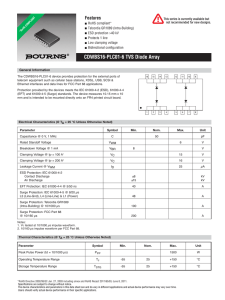
Simulating Scintillation Pulses
with an LED Light Pulser
LED stands for Light Emitting Diode. It
An LED is a diode that emits light when
is a special type of diode that emits light
it is forward biased. A typical LED has a
when an electric current flows through it.
forward resistance of a few 100 ohms
It can be used to simulate a scintillation
and a reverse resistance of 5 megohms.
pulse to test the electronic circuits in the
Most LED’s are operated at 10 to 20
measurement system.
milliamperes of current. In the forward
A diode is a device that has high resistance
to the flow of electric current in one
direction and a low resistance to the flow
of electric current in the other direction.
The symbol for a diode is an arrow
pointing to a short line.
biased mode of operation, too much
current can damage or destroy an LED.
To make sure that the current is limited, a
series resistor is used. The resistor’s value
is calculated by Ohm’s law, V = IR, where V
is in volts, I is in amperes and R is in ohms.
For a 1 volt supply, R=100 ohms to get the
10 milliampere current and for a 10 volt
supply R=1000 ohms. The symbol for an
Electric current can flow through the
diode easily in the direction of the arrow.
The wire lead that is negative (cathode)
LED is that of a diode but with a photon
of light leaving the arrow.
R
Volts
Threshold
is marked on the diode with a metal tab,
Seconds
flat spot, short lead or colored dot. With
a positive potential (voltage) applied on
the positive lead and the current return
connected to the other lead, a very large
current will flow. (This is assuming, of
course, that it is above a threshold level.
For an LED, the threshold is about 1 or
2 volts.) This is called forward biasing;
and since the diode has little resistance
in this direction, the current will be quite
large. If the positive and return leads are
switched, there will be very little current
flow. The diode has high resistance in the
reverse polarity (or reverse bias) mode.
To simulate a scintillation pulse, an LED
is operated in a pulsed mode. The light
Amperes
being emitted by the LED is proportional
to the current flowing through the
Seconds
diode. The current is proportional to
the area of the exciting voltage above
the LED threshold level. Consider first
a trapezoidal voltage pulse. The chart
below shows the applied voltage above
and the resulting current flow (Figure 1).
Figure 1
Simulating Scintillation Pulses
with an LED Light Pulser
USA
Saint-Gobain Crystals
17900 Great Lakes Parkway
Hiram, OH 44234
Tel: (440) 834-5600
Fax: (440) 834-7680
Europe
Saint-Gobain Crystals
104 Route de Larchant
BP 521
77794 Nemours Cedex, France
Tel: 33 (1) 64 45 10 10
Fax: 33 (1) 64 45 10 01
P.O. Box 3093
3760 DB Soest
The Netherlands
Tel: 31 35 60 29 700
Fax: 31 35 60 29 214
Japan
The instantaneous current is proportional to
It should be noted that the light output of LEDs
the voltage above threshold divided by the total
is exponentially dependent on temperature (note
resistance. The total light produced by the LED is
the chart below for a Hewlett Packard LED). Since
proportional to the area of this trapezoid which is
most LEDs are encased in an insulator and the
mathematically equal to the total charge passing
only heat sinks are through the two leads, they
through the LED. A photomultiplier tube’s output
can get quite hot rapidly, changing the output as
would be proportional to the percentage of this
it operates. For this reason, LEDs are not used for
light that it collects and hence to the total charge
gain stabilizing scintillation detectors. (They are,
passing through the LED.
however, used in many devices as a light source
to check functionality.) There are gain stabilizing
A square pulse can be used also. If the sensing
systems and devices available that employ LEDs.
electronics is sensitive to the total charge output
These have internal feedback loops to control
of the PMT only, then any shaped pulse can be
the stability of light output. Berkeley Nucleonics
used. Square pulse generators are available and
Corporation manufactures such systems, and
the area under the current curve (the total charge)
Integrated Photomatrix Limited manufactures
is simply the product of the current (in amperes)
devices called self-monitoring emitters.
times the duration (in seconds) to yield the total
charge in coulombs.
If preamplifiers and shaping amplifiers are used,
the square pulse can generate pulses that do not
Saint-Gobain KK, Crystals Division
3-7, Kojimachi, Chiyoda-ku,
Tokyo 102-0083 Japan
Tel: 81 (0) 3 3263 0559
Fax: 81 (0) 3 5212 2196
match the scintillator pulse’s shape. In these cases,
China
above the diode threshold can produce current
Saint-Gobain (China) Investment
Co, Ltd
15-01 CITIC Building
19 Jianguomenwai Ave.
Beijing 100004 China
Tel: 86 (0) 10 6513 0311
Fax: 86 (0) 10 6512 9843
a tail pulse generator can be used to excite the LED
and to simulate a scintillation pulse shaped event.
Again, only the area of the exciting voltage pulse
flow in the diode.
For further information on a specific LED, the
manufacturer should be contacted.
India
Saint-Gobain Crystals and
Detectors
Sy. No. 171/2, Maruthi Industrial
Estate
Hoody Rajapalya, Whitefield Main
Road
Bangalore 560048 India
Tel: 91 80 42468989
Fax: 91 80 28416501
www.crystals.saint-gobain.com
The data presented are believed to be correct but are not guaranteed to be so.
©2004-15 Saint-Gobain Ceramics & Plastics, Inc. All rights reserved.
(01/15)




